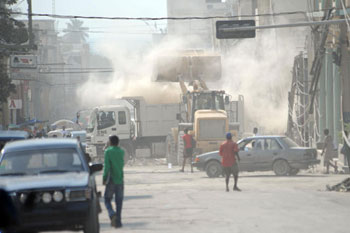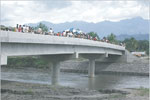Haiti Earthquake: GAO Reports on Past Disasters
Haiti Earthquake: GAO Reports on Past Disasters
|
GAO has long conducted work on the effectiveness of U.S. disaster assistance, both domestically and overseas. This Web site focuses on GAO's disaster assistance work; the findings contained in these reports may be applicable to ongoing and future aid efforts in Haiti as well as to other natural disasters. GAO's work includes insights into improving assistance, based on limitations and successes identified with past efforts. For foreign disaster assistance, GAO's prior work highlights the need to coordinate with host governments and local organizations, and establish monitoring procedures to ensure accountability. After Hurricane Katrina, GAO emphasized that clearly defined leadership roles and responsibilities, appropriate capabilities, and accountability over resources are necessary elements for addressing a catastrophic disaster. |

Haiti's National Palace building damaged by the earthquake.
Source: USAID/uncredited photo |
Key GAO Reports
Highlighted below are key GAO reviews of U.S. assistance following particular events, including U.S. government responses to
- Hurricanes Katrina and Mitch in 2005 and 1998, respectively,
- the Indian Ocean tsunami in 2004,
- tropical storms and hurricanes in the Caribbean in 2004, and
- earthquakes in El Salvador in 2001.
Indian Ocean tsunami, 2004: USAID established financial and technical oversight for its recovery programs, including a concurrent audit of a major road-construction project. However, GAO found that USAID increased initial cost estimates and reduced or canceled some project activities. USAID later extended completion dates for some major construction efforts. In response to GAO recommendations, USAID's reports to Congress included funding information showing progress in reconstruction activities, factors affecting project implementation, and mitigation strategies. |
|
Hurricane Katrina, 2005: Dedicated efforts by many representing government and other entities saved thousands of lives after Hurricanes Katrina and Rita. For example, the Coast Guard quickly mounted a massive search and rescue effort, many states sent personnel and supplies, and private and nonprofit organizations supplemented governmental efforts. However, GAO reported that numerous U.S. departments' and agencies' disaster assistance programs were ineffective, and identified means of improvement. In response to a GAO recommendation, FEMA established contracts for supplies and service that can be activated quickly. |
|
Hurricane and storms in the Caribbean, 2004: USAID completed many of its recovery activities within the one-year time frame, despite periods of severe weather. GAO also found that USAID experienced coordination and security challenges, resulting in construction delays and disruptions, and GAO compiled lessons learned for use in future assistance efforts. In response to a GAO recommendation, USAID provided staff with lessons learned from prior disaster recovery programs to manage future efforts more effectively. |
|
El Salvador earthquakes, 2001: USAID used implementing organizations with a proven record in accounting for funds. However, GAO reported that some USAID construction activities, such as the construction of some houses for low-income people, were behind schedule and lacked benchmarks to measure progress. In response to a GAO recommendation, USAID accelerated construction activities and established interim milestones to benchmark progress toward achieving program goals. |
|
Hurricane Mitch in Central America, 1998: USAID, in coordination with numerous other U.S. departments and agencies, carried out a large-scale recovery program mostly within agreed-upon time frames. GAO further reported that USAID lacked a 'surge capacity' to quickly design and initiate key program activities. GAO recommended that USAID develop and implement procedures for quickly hiring and reassigning personnel in post-disaster situations. |
International Audit Community
GAO and other Supreme Audit Institutions in more than 180 countries are members of the International Organization of Supreme Audit Institutions (INTOSAI), an independent, nongovernmental umbrella organization of external government audit institutions worldwide.
Following the December 2004 Indian Ocean tsunami, INTOSAI established a Task Force to enhance transparency of and accountability for assistance to the tsunami-affected countries. In November 2008, the Task Force ended its work and presented numerous conclusions and lessons learned that highlighted the importance of, among other things, planning before a disaster occurs, monitoring funds in post-disaster situations, coordinating among donor and recipient governments and other organizations, and using geospatial information in planning, monitoring and coordination.
Since then, as a result of the work of the Task Force, INTOSAI has established a follow-on Working Group on the Accountability for and Audit of Disaster-related Aid (AADA). AADA's focus is on the development of good practices relating to the accountability and audit of international assistance. See the AADA's Web site to learn about its mission and work.




















